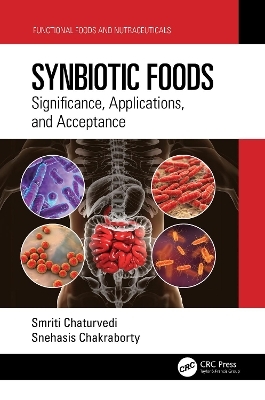
Synbiotic Foods
CRC Press (Verlag)
978-1-032-29337-0 (ISBN)
This is a pioneering book on synbiotic foods, being the first of its kind to include the following features:
Explores fundamental aspects across various matrices
Chapter summaries via 10 concise bullet points
Multiple-choice questions (MCQs) aiding study for national-level competitive exams
Short and long descriptive answer-type questions for comprehensive exam preparation
Designed as a one-stop resource, this book particularly appeals to undergraduate and postgraduate students of Food Science, Food Technology, Food Biotechnology and Food Microbiology.
Dr. Smriti Chaturvedi is a post-doctoral candidate from the School of Engineering, University of Guelph, Canada. Her research focuses on synbiotic foods, probiotics and prebiotics, legume-based non-dairy food products, product optimization, and food safety. Dr. Snehasis Chakraborty is an Assistant Professor of Food Technology at the Institute of Chemical Technology, Mumbai, India. He is a visiting scientist at Kansas State University, USA. His research area includes synbiotic foods, non-thermal and advanced thermal processing of foods, process optimization, kinetic modelling, shelf-life study, and sensory analysis. He is the academic editor for Journal of Food Processing and Preservation and Journal Food Biochemistry. He is also an editorial board member of the journal Applied Food Research.
Table of Contents
PREFACE
CHAPTER 1
Introduction to Synbiotics
1.1 Probiotic
1.2 Prebiotic
1.3 Synbiotics
1.4 Mechanism
1.4.1 Probiotics
1.4.2 Prebiotics
1.4.3 Synbiotics
1.5 Health benefits
1.5.1 Metabolic syndrome
1.5.2 Inflammatory bowel disease
1.5.3 Irritable bowel syndrome
1.5.4 Diarrhea
1.5.5 Colon cancer
1.5.6 Kidney and Liver Diseases
1.5.7 Microbiome gut-brain axis
1.6 Summary
1.7 Multiple choice questions
1.8 Short answer type questions
1.9 Descriptive questions
1.10 References
1.11 Suggested readings
1.12 Answers for MCQs
CHAPTER 2
Synbiotics in Dairy Industry
2.1 Dairy products as carriers of probiotics and prebiotics
2.1.1 Milk
2.1.2 Yogurt
2.1.3 Cheese
2.1.4 Ice cream
2.1.5 Butter and cream
2.1.6 Powdered milk and infant formulas
2.2 Health benefits
2.3 Challenges faced by Synbiotic Dairy products
2.4 Summary
2.5 Multiple choice questions
2.6 Short answer type questions
2.7 Descriptive questions
2.8 References
2.9 Answers for MCQs
CHAPTER 3
Synbiotics in Non-Dairy Industry
3.1 Need for non-dairy synbiotics
3.2 Non-dairy products as potential probiotic carriers
3.2.1 Fruits and vegetables
3.2.2 Cereals
3.2.3 Legumes and Pulses
3.2.4 Meat
3.2.5 Food processing waste
3.3 The prebiotic activity of non-dairy products
3.4 Processing and formulation of synbiotic non-dairy products
3.4.1 Encapsulation of probiotics in the synbiotic system
3.5 Health benefits
3.5.1 Synbiotics for the Reducing Asthma
3.5.2 Synbiotics for Enhancing the Immune System
3.5.3 Synbiotics for Reducing the Risk of Cancer
3.5.4 Synbiotics for trauma patients
3.6 Challenges and Future Scope
3.7 Summary
3.8 Multiple choice questions
3.9 Short answer type questions
3.10 Descriptive questions
3.11 References
3.12 Suggested Readings
3.12 Answers for MCQs
CHAPTER 4
Synbiotics in Cereal Industry
4.1 Cereal and cereal products for the development of synbiotic products
4.1.1 Oat-based products
4.1.2 Malt-based products
4.1.3. Wheat-Based Products
4.1.4. Rice-Based Products
4.1.5. Maize-Based Products
4.1.6. Millet-Based Products
4.1.7 Fermented Pseudocereal Beverages
4.2 Summary
4.3 Multiple choice questions
4.4 Short answer type questions
4.5 Descriptive questions
4.6 References
4.7 Answers for MCQs
CHAPTER 5
Synbiotics in Legume Industry
5.1 Legumes and legume-based products for the development of synbiotic foods
5.1.1 Soybeans
5.1.2 Chickpeas
5.1.3 Kidney beans
5.1.4 Other Varieties of Legumes and Blends
5.2 Processing of pro/synbiotic legume-based food products
5.2.1 Pre-Treatment
5.2.2 Extraction
5.2.3 Fermentation
5.2.4 Enhanced Functionality with Innovative Processing
5.3 Fermented Pro/Synbiotic Legume-based Beverages
5.4 Summary
5.5 Multiple choice questions
5.6 Short answer type questions
5.7 Descriptive questions
5.8 References
5.9 Answers for MCQs
CHAPTER 6
Synbiotics in Fruits &Vegetables Industry
6.1 F&V for the development of synbiotic products
6.2 Fruit and vegetable-based products
6.3 Probiotics as Starter Culture in Fruits and Vegetables-based Synbiotics Products
6.4 Synbiotic F&V-based Food Product: Challenges and their possible solutions
6.5 Synbiotic system from F&V-based waste
6.6 Summary
6.7 Multiple choice questions
6.8 Short answer type questions
6.9 Descriptive questions
6.10 References
6.11 Answers for MCQs
CHAPTER 7
Instant Synbiotic Foods
7.1 Instant Synbiotic Food Products
7.1.1 Dairy-based
7.1.2 Fruit and vegetable-based
7.1.3 Cereal and legume based
7.1.4 Food waste based
7.2 Drying methods
7.2.1 Spray drying
7.2.2 Freeze drying
7.2.3 Foam-mat drying
7.3 Advantages of powdered synbiotic foods
7.3.1 Longer shelf life
7.3.2 Specialty food
7.3.3 Health benefits
7.4 Summary
7.5 Multiple choice questions
7.6 Short answer type questions
7.7 Descriptive questions
7.8 References
7.9 Suggested Readings
7.10 Answers for MCQs
CHAPTER 8
Screening and Evaluation of Synbiotics
8.1 Screening methods
8.1.1 Selection of Probiotics
8.1.2 Selection Criteria for Prebiotic
8.2 Evaluation techniques
8.2.1 Evaluation Techniques for Probiotic Properties
8.2.2 Evaluation Techniques for prebiotic properties
8.3 Summary
8.4 Multiple choice questions
8.5 Short answer type questions
8.6 Descriptive questions
8.7 References
8.8 Suggested Readings
8.9 Answers for MCQs
CHAPTER 9
Market Profile of Synbiotic Foods
9.1 Global market for Synbiotic products
9.2 Market Synopsis of Synbiotic Products
9.3 Summary
9.4 Multiple Choice Questions
9.5 Short answer type Questions
9.6 Descriptive Questions
9.7 References
9.8 Suggested Readings
9.9 Answers for MCQs
CHAPTER 10
Commercial Aspects and Challenges with Synbiotics
10.1 Commercialization of Synbiotics in the Marketplace
10.2 Challenges with Synbiotics
10.2.1 Physiological challenges
10.2.2 Ecological challenges
10.2.3 Challenges during processing
10.3 Future Recommendations for Categorization of Synbiotics
10.4 Multiple-Choice Questions
10.5 Short answer type Questions
10.6 Descriptive Questions
10.7 References
10.8 Suggested Readings
10.9 Answers for MCQs
CHAPTER 11
Synbiotic food products
| Erscheinungsdatum | 13.06.2024 |
|---|---|
| Reihe/Serie | Functional Foods and Nutraceuticals |
| Zusatzinfo | 2 Line drawings, color; 13 Line drawings, black and white; 2 Illustrations, color; 13 Illustrations, black and white |
| Verlagsort | London |
| Sprache | englisch |
| Maße | 156 x 234 mm |
| Gewicht | 453 g |
| Themenwelt | Technik ► Lebensmitteltechnologie |
| ISBN-10 | 1-032-29337-3 / 1032293373 |
| ISBN-13 | 978-1-032-29337-0 / 9781032293370 |
| Zustand | Neuware |
| Haben Sie eine Frage zum Produkt? |
aus dem Bereich


